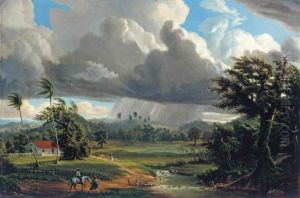Augusto Chartrand Dubois Paintings
Augusto Chartrand Dubois was a Cuban painter known for his landscapes, marine scenes, and his work as an illustrator. Born on September 16, 1869, in Havana, Cuba, he developed an interest in art from a young age. His talent was recognized early on, and he was encouraged to pursue his passion for painting. Chartrand's father was of French descent, and his mother was Cuban, a blend of cultures that may have influenced his artistic development.
Chartrand began his formal art education at San Alejandro Academy, the oldest and most prestigious fine arts school in Cuba. He later moved to Europe to further his studies, which was a common practice among artists from affluent backgrounds at that time. Chartrand spent time in Paris, France, which was then the epicenter of the art world. He was exposed to various artistic movements and styles, including Impressionism, which had a lasting impact on his work.
Returning to Cuba, Chartrand quickly established himself as a prominent figure in the Cuban art scene. He was known for his mastery of light and color, particularly in his depictions of the Cuban landscape and coastal scenes. His paintings often reflected the beauty of the Cuban countryside and the island's vibrant coastal areas, capturing the unique tropical light and atmosphere. Chartrand's work was exhibited in numerous shows, both in Cuba and internationally, earning him significant recognition.
Throughout his career, Chartrand also worked as an illustrator for various publications. His illustrations contributed to the visual culture of the period and complemented his work as a painter. Despite the popularity of his marine and landscape paintings, Chartrand was also adept at portraiture and genre scenes.
Chartrand's contributions to Cuban art were significant, as he was part of a generation of artists who helped shape the nation's cultural identity during a time of political and social change. He remained active in the Cuban art community until his death on April 8, 1937, in Havana. Today, his works are considered an integral part of Cuba's artistic heritage and are held in high esteem by collectors and art historians alike.
